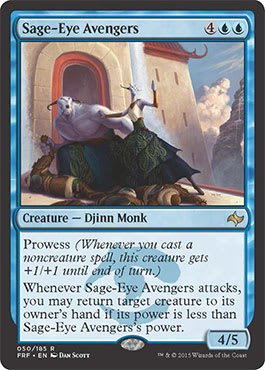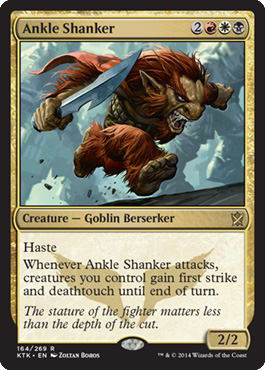Now that Fate Reforged has been out for a few weeks, it seems that the new set has really shaken up the Draft format. Because the new set is so different than Khans of Tarkir, the format has shifted in ways that we don’t usually see when a small set comes out. Things that have changed include:
- The absence of three-color cards in pack one means it’s much easier to stay open. Most players will now settle into an enemy color pair (W/B, U/R, B/G, R/W, or G/U) in pack one and then either stay with two colors or splash a third to play whichever wedge is more open in the second and third packs.
- That said, it is much more feasible to play an allied-color pair. Because the number of multicolored cards has decreased, there are fewer incentives to be in specific color pairs. Additionally, some of the mechanics in Fate Reforged, such as prowess (W/U) and ferocious (R/G), only appear in two allied colors, meaning that decks built around them will play those colors.
- There is a higher density of broken rares in this set than in most. Add that to the fact that none of them commits you to three colors anymore, and you have a format in which, most of the time, you’re going to first-pick a rare.
Listeners of Marshall Sutcliffe and Luis Scott-Vargas’s podcast Limited Resources will be familiar with the difference between a “prince” format and a “pauper” format. In a pauper format, Draft games are usually dictated by synergies between common and uncommon cards, and in a prince format, games are more often about powerful spells, usually rares, and having the right answers to them. No format is completely one way or the other, but most can be categorized as being closer to one end of the spectrum than the other.
The introduction of Fate Reforged has undoubtedly shifted the format toward the prince end of the spectrum. The power and resilience of the rares in the set, along with the diminished overall power of the common cards in Fate Reforged, means that more games come down to one powerful spell. Additionally, some of the best rares are enchantments, such as Mastery of the Unseen, Citadel Siege, and Outpost Siege, meaning that if you don’t have an enchantment-removal spell, the game will quickly go out of reach.
As in any other Draft format, though, there are ways you can adapt. One way to do this is to play a fast, two-color aggro deck that tries to end the game before the opponent can use his or her powerful spells. The other is to play a control deck with a lot of card advantage and the right answers to your opponent’s threats. Today, I’d like to focus on how to approach drafting a strong, two-color, aggressive deck in this format.
Two-Color Aggro Draft Guide
Good aggro decks in this format have two advantages that you don’t have in most Draft formats: They have better mana than most other decks, and they start playing important spells a turn earlier than their opponents. If at all possible, you want to keep your aggressive decks based in two colors, maybe splashing for a bomb rare and/or a removal spell. If you start the Draft in R/W and open an Ankle Shanker in pack two, it’s worth it to play a third color. Splashing for morphs is also fine since you’re still playing a 2/2 for 3 even if you don’t draw your splash color. Beyond that, though, you really want to stay in two colors to give yourself the edge in consistency over your opponent.
Another benefit of being two colors is that you will have fewer lands that enter the battlefield tapped, which allows you to start casting spells sooner. When the overall power level of your cards is lower than those of your opponents—which will often be the case when playing an aggro deck—the most important axis on which to attack is to gain a tempo advantage.
The other important way to do this is to prioritize 2-drops. While having one fewer pack of Khans of Tarkir means fewer morphs, the format still revolves around turn-three plays. The majority of these will still be 2/2s for 2, which means that if you have a creature on the board on turn two, it can easily attack into your opponent’s 3-drop. Look out especially for cards like Wandering Champion, Frost Walker, and Temur Charger, which can even attack through 2/3s.
In the Top 8 of Grand Prix Mexico City, Martin Juza drafted a straight R/W aggro deck. Here’s his decklist:
R/W Aggro ? Fate Reforged Draft | Martin Juza
- Creatures (14)
- 1 Alabaster Kirin
- 1 Dragonscale General
- 1 Highspire Mantis
- 1 Horde Ambusher
- 1 Leaping Master
- 1 Valley Dasher
- 2 Aven Skirmisher
- 2 Canyon Lurkers
- 2 Mardu Hordechief
- 2 Smoldering Efreet
- Spells (9)
- 1 Pressure Point
- 1 Take Up Arms
- 1 Trumpet Blast
- 1 War Flare
- 1 Act of Treason
- 1 Arrow Storm
- 1 Soul Summons
- 2 Mardu Runemark
Juza’s deck tries to flood the board with small creatures to deal early damage, and then it uses cards like Trumpet Blast and War Flare to finish off the opponent.
As always, it’s important for your aggro deck to have reach: the ability to close out a game in which you’re ahead in the race. In past Limited formats, you had access to very efficient removal spells such as Doom Blade and Pacifism, meaning it was often enough for an aggro deck to curve out and cast removal spells to win the game. There are a few cards like this in the format, such as Wild Slash, Valorous Stance, Debilitating Injury, and Savage Punch, but they are hard to come by.
This means ways to remove blockers are at a premium. A card like Crippling Chill, which was unexciting in previous formats, is very good in this format. The same goes for cards like Will of the Naga, Goblin Heelcutter, and Barrage of Boulders.
Creatures with evasion are also essential to a good aggro deck. Mystic of the Hidden Way has been called the best blue common in Khans of Tarkir, and this hasn’t changed much, though Aven Surveyor could give it a run for its money. One thing to keep in mind is that there are a bunch of 4/4 flying Dragons running around, meaning that your flyers will often become outclassed later in the game.
A good way to make sure your creatures don’t become blanked is to play Trumpet Blast effects. Playing a card that pumps all your creatures helps you leverage the advantage of putting creatures on the board faster than your opponent. Even better than Trumpet Blast are cards like War Flare and Rush of Battle, which allow you to send in all your creatures without worrying about your opponent’s next attack.
Having access to blocker removal, evasion, and reach is what separates a good aggro deck from a bad one. Because of this, having access to these effects is crucial, and it means that certain color combinations are unlikely to lead to a strong deck. Having access to blue gives you good evasive creatures and ways to break board stalls. Red gives you cards like Barrage of Boulders and Trumpet Blast to break board stalls. This means you generally want to play at least one of those colors in your aggro decks.
Juan Carlos Botis used both of these colors in his aggro deck in the Top 8 of Grand Prix Mexico City. Here’s his decklist:
U/R Aggro ? Fate Reforged Draft | Juan Carlos Botis
- Creatures (13)
- 1 Bloodfire Expert
- 1 Dragon-Style Twins
- 1 Flamerush Rider
- 1 Jeskai Elder
- 1 Lightning Shrieker
- 1 Lotus Path Djinn
- 1 Mistfire Weaver
- 1 Scion of Glaciers
- 1 Shockmaw Dragon
- 1 Vaultbreaker
- 1 War-Name Aspirant
- 2 Goblin Heelcutter
- Spells (10)
- 1 Bring Low
- 1 Burn Away
- 1 Collateral Damage
- 1 Crippling Chill
- 1 Force Away
- 1 Waterwhirl
- 1 Winterflame
- 1 Arc Lightning
- 2 Bathe in Dragonfire
- Lands (17)
- 7 Island
- 8 Mountain
- 1 Frontier Bivouac
- 1 Swiftwater Cliffs
Juan’s deck is full of ways—such as Crippling Chill, Winterflame, and Waterwhirl—to remove blockers and push through damage. This gives him a lot of ways to win the game once he’s ahead.
Choosing Your Colors
There are many different ways to be aggressive in this format. R/W is probably the best strategy because of the token synergies, with U/R, W/U, and R/G also being strong options. W/B is still solid, but it’s much weaker than before due to the lack of many Warriors in the new set. Sandsteppe Outcast and Harsh Sustenance are good additions, though, and Rush of Battle still wins games.
G/U is another deck that became worse—this is because of the weakness of aggressive green commons in the new set. The best way to make green aggro good is to pair it with red to maximize your ferocious cards. G/W is more suited to a more midrange, outlast strategy than it is to an aggressive deck. In general, the black cards in the format don’t lend themselves to an aggressive strategy unless paired with white.
In summary, here’s what you should keep in mind while drafting an aggro deck in this format:
- Stick to two colors if possible, only splashing for bombs and morphs. This also means you can play seventeen lands.
- Play a lot of 2-drops, even as many as six or seven, to pull ahead of your opponent.
- Make sure you have ways to remove blockers.
- Prioritize creatures with evasion.
- Play cards that make your small creatures stay relevant.
I hope this article helps you gain a sense of how to plan your aggressive Draft strategies. Next, I’ll be taking a look at drafting multicolored control decks. Thanks for reading!






























